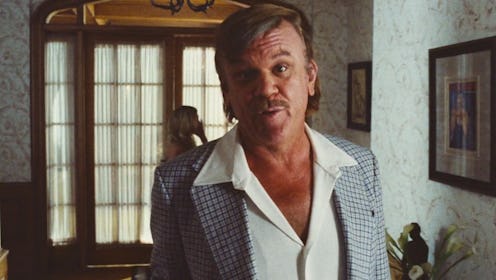It’s Time to Rebuild the Fourth Wall
Characters in film and television must stop speaking directly to us.

What if you could get a television audience in 2022 to care about basketball? This seems to be the question on the minds of the team behind HBO’s new series Winning Time, executive produced by Adam McKay. Based on Jeff Pearlman’s book Showtime: Magic, Kareem, Riley and the Los Angeles Lakers Dynasty of the 1980s, the series follows one of the most exciting periods in the history of one of the NBA’s most popular franchises, and gosh, if only there were a way to make that interesting for people. Oh, wait — Adam McKay knows a way: constant breaking of the fourth wall. Whew!
McKay directed Winning Time’s pilot episode, and fourth-wall breaking is, obviously, one of his main tricks. In his movies, most recently Don’t Look Up and most notably The Big Short, characters, chyrons, and graphics often speak directly to the audience as a way to explain, in a cheeky way, what is going on on-screen; or to, again in a cheeky way, affirm to the audience that what they’re seeing is in fact ridiculous.
It’s a pretty good trick when the person speaking directly to us is Anthony Bourdain, and he’s explaining whatever “collateralized debt obligation” is. The reason behind that use of fourth-wall breaking, in The Big Short, was clear: this was boring, but necessary, information that had to be relayed in a captivating way. The reason for McKay’s trick is less clear, though, when the person speaking directly to us is John C. Reilly, and what he’s explaining is that basketball is “like great sex” (because there is rhythm involved, and bodies). Ahh … like great sex you say? Well, I might just be interested in this “basketball” after all!
In the first 15 minutes of Winning Time, four main characters break the fourth wall, each multiple times. There are two instances of meta-fourth-wall breaking: characters replying directly to camera to what another character has said directly to camera. There are three instances of informative fourth-wall breaking graphics. The gimmick is immediately tiresome, and it continues, though less frequently, throughout the entire series. It is as if Adam McKay saw Fleabag and thought, “But what if every element of a TV show were Fleabag talking to the camera?” And “but what if every element of a TV show were Fleabag talking to the camera?” is a fine thought to have while watching Fleabag, sure, as long as it is followed at some point by the thought, “It would be very annoying.” Alas, in this case, it was not.
In Fleabag and Michaela Coel’s Chewing Gum, as well as in movies like Annie Hall, Ferris Bueller's Day Off, and High Fidelity, breaking the fourth wall works as a gag because it contrasts what one might ordinarily see; it’s a little dangerous and unexpected. It works, like in The Big Short, when it feels like you and the filmmaker are in on a secret. In that case the secret was, yes this material is boring, and because of that we aren’t going to attempt to “show” rather than “tell,” which is what film school instructed us to do; we’re just going to tell and get it over with. Unfortunately we have made too-liberal use of this trick, “we” meaning primarily Adam McKay, and it has swung back around from being inspired to being cheap and also so annoying that I cannot stand it for another minute.
It is because of this I have to declare a temporary ban on breaking the fourth wall in television and movies. I hate to do it, but if you need more evidence as to why it is necessary I will point you to Wes Anderson’s failed award show bait The French Dispatch, which also made excessive use of fourth-wall breaking in its narration, as well as to Deadpool and its whole deal. (And, of course, Don’t Look Up, where the fourth wall-breaking comes in the form of on-screen graphics that inform us that “the Planetary Defense Coordination Office is a real place, and this is its logo.") Yes, the ban will also be enforced for Phoebe Waller-Bridge. We are currently drowning in Ferris Buellers, and in order to bail ourselves out of this sinking ship, we need to take serious action.
For the time being, if you want the audience to understand something, you will have to find a way to portray it in action and dialogue. “But how will the audience know that, in fact, the NBA wasn’t as popular as it is today, if John C. Reilly doesn’t tell them directly?” You will find a way. “But how will we show that we understand sexism is taking place if a woman doesn’t look at the camera and roll her eyes?” You will have to trust your audience, and if that isn’t enough, you will have to question what you are doing that makes your audience not understand that this is the point you are attempting to make in the first place. “But how will we do a funny graphic?” you won’t.
Of course I don’t want Adam McKay to lose his livelihood, so this ban is only temporary. Maybe in a decade we’ll be ready for a character to look into the camera and talk to us again. We’ll assess at that time, and Adam McKay will have to spend on a budget until then. But for now, and for the foreseeable future, it is not allowed.
(Me looking into the computer directly at you) my apologies.